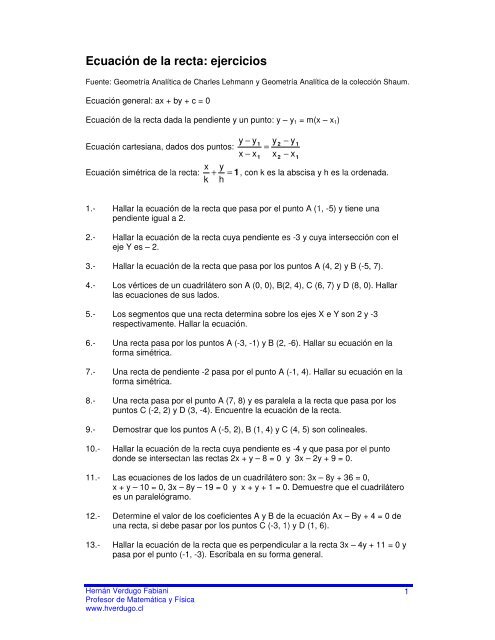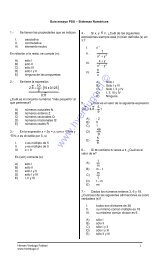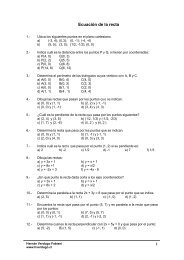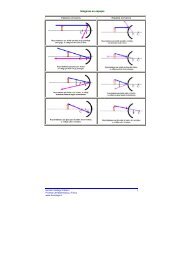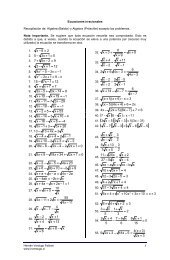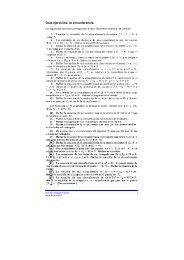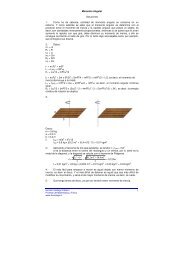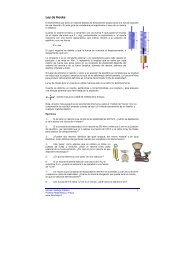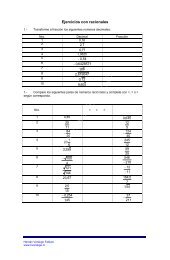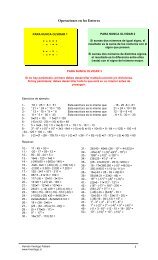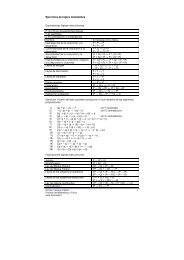Ecuación de la recta - Ejercicios de fÃsica y matemática
Ecuación de la recta - Ejercicios de fÃsica y matemática
Ecuación de la recta - Ejercicios de fÃsica y matemática
You also want an ePaper? Increase the reach of your titles
YUMPU automatically turns print PDFs into web optimized ePapers that Google loves.
Ecuación <strong>de</strong> <strong>la</strong> <strong>recta</strong>: ejercicios<br />
Fuente: Geometría Analítica <strong>de</strong> Charles Lehmann y Geometría Analítica <strong>de</strong> <strong>la</strong> colección Shaum.<br />
Ecuación general: ax + by + c = 0<br />
Ecuación <strong>de</strong> <strong>la</strong> <strong>recta</strong> dada <strong>la</strong> pendiente y un punto: y – y 1 = m(x – x 1 )<br />
y − y1<br />
y<br />
2<br />
− y1<br />
Ecuación cartesiana, dados dos puntos: =<br />
x − x1<br />
x<br />
2<br />
− x1<br />
x y<br />
Ecuación simétrica <strong>de</strong> <strong>la</strong> <strong>recta</strong>: + = 1, con k es <strong>la</strong> abscisa y h es <strong>la</strong> or<strong>de</strong>nada.<br />
k h<br />
1.- Hal<strong>la</strong>r <strong>la</strong> ecuación <strong>de</strong> <strong>la</strong> <strong>recta</strong> que pasa por el punto A (1, -5) y tiene una<br />
pendiente igual a 2.<br />
2.- Hal<strong>la</strong>r <strong>la</strong> ecuación <strong>de</strong> <strong>la</strong> <strong>recta</strong> cuya pendiente es -3 y cuya intersección con el<br />
eje Y es – 2.<br />
<br />
3.- Hal<strong>la</strong>r <strong>la</strong> ecuación <strong>de</strong> <strong>la</strong> <strong>recta</strong> que pasa por los puntos A (4, 2) y B (-5, 7).<br />
4.- Los vértices <strong>de</strong> un cuadrilátero son A (0, 0), B(2, 4), C (6, 7) y D (8, 0). Hal<strong>la</strong>r<br />
<strong>la</strong>s ecuaciones <strong>de</strong> sus <strong>la</strong>dos.<br />
5.- Los segmentos que una <strong>recta</strong> <strong>de</strong>termina sobre los ejes X e Y son 2 y -3<br />
respectivamente. Hal<strong>la</strong>r <strong>la</strong> ecuación.<br />
6.- Una <strong>recta</strong> pasa por los puntos A (-3, -1) y B (2, -6). Hal<strong>la</strong>r su ecuación en <strong>la</strong><br />
forma simétrica.<br />
7.- Una <strong>recta</strong> <strong>de</strong> pendiente -2 pasa por el punto A (-1, 4). Hal<strong>la</strong>r su ecuación en <strong>la</strong><br />
forma simétrica.<br />
8.- Una <strong>recta</strong> pasa por el punto A (7, 8) y es parale<strong>la</strong> a <strong>la</strong> <strong>recta</strong> que pasa por los<br />
puntos C (-2, 2) y D (3, -4). Encuentre <strong>la</strong> ecuación <strong>de</strong> <strong>la</strong> <strong>recta</strong>.<br />
9.- Demostrar que los puntos A (-5, 2), B (1, 4) y C (4, 5) son colineales.<br />
10.- Hal<strong>la</strong>r <strong>la</strong> ecuación <strong>de</strong> <strong>la</strong> <strong>recta</strong> cuya pendiente es -4 y que pasa por el punto<br />
don<strong>de</strong> se intersectan <strong>la</strong>s <strong>recta</strong>s 2x + y – 8 = 0 y 3x – 2y + 9 = 0.<br />
11.- Las ecuaciones <strong>de</strong> los <strong>la</strong>dos <strong>de</strong> un cuadrilátero son: 3x – 8y + 36 = 0,<br />
x + y – 10 = 0, 3x – 8y – 19 = 0 y x + y + 1 = 0. Demuestre que el cuadrilátero<br />
es un paralelógramo.<br />
12.- Determine el valor <strong>de</strong> los coeficientes A y B <strong>de</strong> <strong>la</strong> ecuación Ax – By + 4 = 0 <strong>de</strong><br />
una <strong>recta</strong>, si <strong>de</strong>be pasar por los puntos C (-3, 1) y D (1, 6).<br />
<br />
<br />
<br />
13.- Hal<strong>la</strong>r <strong>la</strong> ecuación <strong>de</strong> <strong>la</strong> <strong>recta</strong> que es perpendicu<strong>la</strong>r a <strong>la</strong> <strong>recta</strong> 3x – 4y + 11 = 0 y<br />
pasa por el punto (-1, -3). Escríba<strong>la</strong> en su forma general.<br />
<br />
<br />
Hernán Verdugo Fabiani<br />
Profesor <strong>de</strong> Matemática y Física<br />
www.hverdugo.cl<br />
1
14.- Hal<strong>la</strong>r el valor <strong>de</strong> k para que <strong>la</strong> <strong>recta</strong> kx + (+ - 1)y – 18 = 0 sea parale<strong>la</strong> a <strong>la</strong><br />
<strong>recta</strong> <strong>de</strong> ecuación 4x + 3y + 7 = 0.<br />
15.- Determine el valor <strong>de</strong> k para que <strong>la</strong> <strong>recta</strong> k 2 x + (x + 1)y + 3 = 0, sea<br />
perpendicu<strong>la</strong>r a <strong>la</strong> <strong>recta</strong> 3x – 2y – 11 = 0.<br />
16.- Hal<strong>la</strong>r <strong>la</strong> pendiente y <strong>la</strong>s intersecciones <strong>de</strong> <strong>la</strong> <strong>recta</strong> con los ejes coor<strong>de</strong>nados <strong>de</strong><br />
<strong>la</strong> <strong>recta</strong> 7x – 9y + 2 = 0.<br />
17.- En <strong>la</strong>s ecuaciones ax + (2 – b)y – 23 = 0 y (a – 1)x + by + 15 = 0, hal<strong>la</strong>r los<br />
valores <strong>de</strong> a y b para que representen <strong>recta</strong>s que pasan por el punto (2, -3).<br />
18.- Demostrar que <strong>la</strong>s <strong>recta</strong>s 2x – y = 0, x – 8y + 37 = 0, 2x – y – 16 = 0 y<br />
x - 8y + 7 = 0 forman un paralelógramo.<br />
19.- Demostrar que <strong>la</strong>s <strong>recta</strong>s 5x – y – 6 = 0, x + 5y – 22 = 0; 5x – y – 32 = 0 y<br />
x + 5y + 4 = 0 forman un cuadrado.<br />
20.- Hal<strong>la</strong>r <strong>la</strong> distancia entre el origen y <strong>la</strong> <strong>recta</strong> 2x – 3y + 9 = 0.<br />
<br />
21.- Hal<strong>la</strong>r el valor <strong>de</strong> k para que <strong>la</strong> distancia <strong>de</strong>l origen a <strong>la</strong> <strong>recta</strong> x + ky – 7 = 0 sea<br />
2.<br />
22.- La pendiente <strong>de</strong> una <strong>recta</strong> es -3. Hal<strong>la</strong>r su ecuación si su distancia al origen es<br />
2. Tiene dos soluciones.<br />
23.- Hal<strong>la</strong>r <strong>la</strong> ecuación <strong>de</strong> <strong>la</strong> <strong>recta</strong> que es parale<strong>la</strong> a <strong>la</strong> que tiene por ecuación<br />
3x + 2y – 9 = 0 y cuya distancia al origen es 8. Dos soluciones.<br />
24.- Hal<strong>la</strong>r <strong>la</strong> distancia <strong>de</strong> <strong>la</strong> <strong>recta</strong> 3x – 5y + 10 = 0 al punto P (2, -3).<br />
25.- Hal<strong>la</strong>r <strong>la</strong> distancia <strong>de</strong>s<strong>de</strong> <strong>la</strong> <strong>recta</strong> x + 2y + 7 = 0 al punto P (1, 4).<br />
26.- Hal<strong>la</strong>r <strong>la</strong> distancia comprendida entre <strong>la</strong>s <strong>recta</strong>s parale<strong>la</strong>s 3x – 4y + 8 y<br />
6x - 8y + 9 = 0.<br />
27.- Hal<strong>la</strong>r <strong>la</strong> distancia entre <strong>la</strong>s <strong>recta</strong>s parale<strong>la</strong>s x + 2y – 10 = 0 y x + 2y + 6 = 0.<br />
28.- Hal<strong>la</strong>r <strong>la</strong> ecuación <strong>de</strong> <strong>la</strong> <strong>recta</strong>: a) que pasa por el punto (-4, 3) y tiene<br />
pendiente1/2, b) que pasa por (0, 5) y tiene pendiente -2.<br />
29.- Hal<strong>la</strong>r <strong>la</strong> ecuación <strong>de</strong> <strong>la</strong> <strong>recta</strong> que pasa por los puntos (-2, -3) y (4, 2).<br />
(5x – 6y – 8 = 0)<br />
30.- Hal<strong>la</strong>r <strong>la</strong> ecuación <strong>de</strong> <strong>la</strong> <strong>recta</strong> cuya abscisa y or<strong>de</strong>nada son 5 y -3,<br />
respectivamente. (3x – 5y – 15 = 0)<br />
31.- Hal<strong>la</strong>r <strong>la</strong> ecuación <strong>de</strong> <strong>la</strong> <strong>recta</strong> que pasa por el punto (2, -3) y es parale<strong>la</strong> a <strong>la</strong><br />
<strong>recta</strong> que une los puntos (4,1) y (-2, 2). (x + 6y + 16 = 0)<br />
<br />
32.- Hal<strong>la</strong>r <strong>la</strong> ecuación <strong>de</strong> <strong>la</strong> <strong>recta</strong> que pasa por el punto (-2, 3) y es perpendicu<strong>la</strong>r a<br />
<strong>la</strong> <strong>recta</strong> 2x – 3y + 6 = 0. (3x + 2y = 0)<br />
33.- Hal<strong>la</strong>r <strong>la</strong> ecuación <strong>de</strong> <strong>la</strong> mediatriz <strong>de</strong>l segmento <strong>de</strong>terminado por los puntos (7,<br />
4) y (-1, -2). (4x + 3y – 15 = 0)<br />
Hernán Verdugo Fabiani<br />
Profesor <strong>de</strong> Matemática y Física<br />
www.hverdugo.cl<br />
<br />
<br />
2
34.- Hal<strong>la</strong>r el valor <strong>de</strong> k <strong>de</strong> forma que:<br />
a) 3kx + 5y + k – 2 = 0 pase por el punto (-1, 4). (9)<br />
b) 4x – ky – 7 = 0 tenga pendiente 3. (4/3)<br />
c) kx – y = 3k – 6 tenga abscisa igual a 5. (-3)<br />
35.- Hal<strong>la</strong>r <strong>la</strong> distancia <strong>de</strong>s<strong>de</strong> <strong>la</strong> <strong>recta</strong>: a) 8x + 15 y – 24 = 0 al punto (-2, -3). (5)<br />
b) 6x – 8y + 5 = 0 al punto (-1, 7). (5,7)<br />
36.- Hal<strong>la</strong>r <strong>la</strong> ecuación <strong>de</strong> <strong>la</strong> <strong>recta</strong> que pasa por el punto <strong>de</strong> intersección <strong>de</strong> <strong>la</strong>s<br />
<strong>recta</strong>s 3x – 2y + 10 = 0 y 4x + 3y – 7 = 0 y el punto (2, 1). (22x + 25y –<br />
69 = 0)<br />
37.- Hal<strong>la</strong>r <strong>la</strong> ecuación <strong>de</strong> <strong>la</strong> <strong>recta</strong> perpendicu<strong>la</strong>r a <strong>la</strong> <strong>recta</strong> 4x + y – 1 que pasa por el<br />
punto <strong>de</strong> intersección <strong>de</strong> 2x – 5y + 3 = 0 y x – 3y – 7 = 0. (x – 4y – 24 = 0).<br />
<br />
<br />
<br />
<br />
<br />
<br />
<br />
Hernán Verdugo Fabiani<br />
Profesor <strong>de</strong> Matemática y Física<br />
www.hverdugo.cl<br />
3


